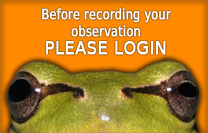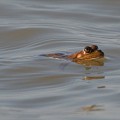
The snout-vent length of the MARSH FROG sometimes reaches 15 cm. Usually it is middle to dark olive-green with a light, green middorsal line and darker olive-green or almost black blotches of variable size on its back. The belly is grayish-white, usually with black patches. The dorsal side of the thighs has grayish-white transversal strips in contrast to the other green frogs which has yellow strips. Their limbs are long, the callus internus is short and moderately protruding. When the thighs are positioned perpendicularly to the body axis, the heels overlap. During breeding season, the male has dark gray nuptial pads on the inner surface of its thumbs, its paired vocal sac is also dark gray.
Distibution map by our National Herpetological Mapping Program:




















